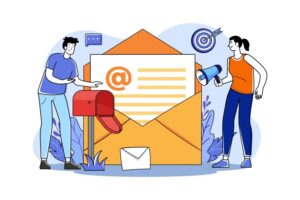Email is an essential tool for businesses to communicate with customers in the modern digital world, but the average person receives over 100 emails per day. This can lead shoppers to email fatigue, a feeling of being inundated by the sheer volume of emails they receive and a sense of being overwhelmed by keeping up with them. Email fatigue causes consumers to lose interest in reading and engaging with them. To combat email fatigue, companies must focus on personalization. It’s the single most effective tool to help businesses stand out from the crowd and engage meaningfully with customers.
Research shows that personalization most often drives a 10 to 15 percent revenue lift. The more skillful a company becomes in applying data to grow customer knowledge and intimacy, the greater the returns. – McKinsey & Co.
What is Personalization?
Personalization is the process of tailoring content, messaging, and recommendations to a shopper’s unique interests, preferences, and behavior to create an individualized shopping experience for each customer. Today’s consumers expect and demand personalization. A recent Forbes article offers compelling consumer statistics:
- 91% say they are more likely to shop with brands that provide offers and recommendations that are relevant to them.
- 72% say they only engage with personalized messaging.
- 71% feel frustrated when a shopping experience is impersonal.
- 63% will stop buying from brands that use poor personalization tactics.
- 36% say retailers need to do more to offer personalized experiences.
“If you like this, you’ll love that”-style product recommendations are everywhere, but there are other ways for businesses to leverage the power of personalization as well, including on their websites and in their email communications.
“Despite emails being a commonly used communications avenue, they remain an essential touchpoint on the consumer journey. Use personalized emails that show you care about your customers and understand what they are trying to achieve. Not only will this cultivate relationships that grow customer lifetime value, but also boost CTRs and per-subscriber revenue.”
-Melissa Grembi, Marketing Manager
Using Personalization to Combat Email Fatigue
Personalization makes customers feel valued and recognized. It makes them feel seen. By tailoring email communication to shoppers’ interests and needs, businesses can increase engagement and build stronger relationships with their customers. Here are some ways to use personalization to reduce email fatigue:
- Collect data and insights.
The first step toward personalization is collecting data and insights about your customers, including information such as their name, location, purchase history, and email activity. By understanding customers’ preferences and behaviors, businesses can create more targeted and relevant emails. Collect this data and generate individual profiles to learn preferences on the most detailed attribute level and make recommendations that demonstrate that insight with Shoptelligence’s STyleMail.
- Transform customer feedback into personalization.
Use the customer feedback you gather through surveys or reviews to suggest products or services that are most interesting to customers. For example, when a customer leaves a positive review about a particular product, follow up with a personalized email with related products or services that they might be interested in.
- Incorporate personalized photos and videos.
Personalized images or videos are effective weapons in the battle against email fatigue. Leverage the customer data gathered across channels to generate unique images or videos that speak directly to the recipient’s interests or preferences. Inspire and delight shoppers with personalized videos showcasing their previous in-store purchases or highlighting products that coordinate with items they’ve viewed on your company’s website.
- Personalize subject lines.
The subject line is the first thing a recipient sees when they receive your email. 47% of email recipients decide whether to open an email based on that subject line alone. By personalizing your subject line with the recipient’s name or referencing their recent behavior, you can make your email stand out and grab their attention. 24% of shoppers also check out the preview text, that 50-100 character copy snippet that appears in their inbox. Make sure that the preview aligns with the subject line and use it to further inspire and incentivize each recipient to open your email.
- Use dynamic content.
Dynamic content involves creating email templates that can be customized for each recipient. This might include personalized recommendations based on their purchase history or tailored content based on their interests. STyleMail by Shoptelligence seamlessly handles this task, combining intelligent understanding of action-based triggers with an ability to actually learn customer preferences. Using unique STyle Reasoning, STyleMail shows your customers options to help them accomplish their shopping goals through automated, customizable communications that they’ll be happy to receive and open.
- Offer time-sensitive promotions and discounts.
By creating personalized promotions or discounts based on the customer’s browsing history or purchase behavior, businesses can not only increase engagement rates and combat email fatigue, but also spur customers to take action and make a purchase. Try sending personalized emails offering discounts on products that you know the customer has previously viewed but hasn’t yet purchased and include a limited-time offer to create a sense of urgency.
- Segment your email list.
Use data collected across channels to segment your email list, grouping your customers based on similar characteristics or behavior. For example, you might have a segment for customers who have made a recent purchase, or for those who have subscribed to your newsletter but have yet to make a purchase. Use these segments to send emails to the most receptive audience, rather than blasting every message to all contacts.
- Use triggered emails.
Triggered emails are automated emails that are sent in response to a specific action or behavior. Personalize them by sending a welcome email to new subscribers or a reminder email to customers who have left items in their cart but have yet to make a purchase.
- Test and optimize.
It’s important to test and optimize your personalized emails. You can accomplish this by A/B testing subject lines and tracking key metrics such as open rates, click-through rates, and conversions, then making adjustments as needed to improve your results.
- Keep it simple.
While personalization is important, it’s also important to keep your emails simple and easy to read. Avoid using too many images or fancy designs, and make sure your message is clear and concise.
Create Omnichannel Personalization with Shoptelligence
Email fatigue is a real problem for businesses. You can beat it with emails that stand out from the crowd, inspiring, delighting, and engaging customers. Incorporating personalization into your email communication strategy will build stronger relationships with your customers and drive more conversions, ultimately leading to greater revenue and growth.
Learn how Shoptelligence can support your success with tools to create personalization at every step of the omnichannel path to purchase. Schedule a product tour today.






